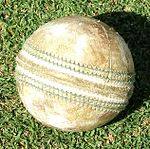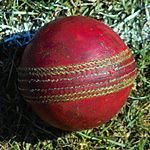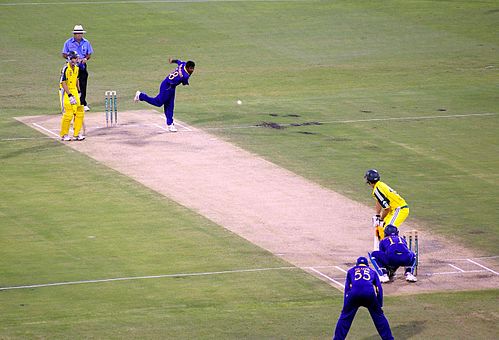Cricket: Difference between revisions
too much detail for this article; should be added to run (cricket) |
|||
| Line 354: | Line 354: | ||
==See also== |
==See also== |
||
* [[Glossary of cricket terms]] |
* [[Glossary of cricket terms]] |
||
* [[Cricket in the United States]] |
|||
==References== |
==References== |
||
Revision as of 14:04, 17 July 2017
 | |
| Highest governing body | International Cricket Council |
|---|---|
| First played | 15th century; south-east England |
| Characteristics | |
| Contact | no |
| Team members | 11 players per side (substitutes permitted in some circumstances) |
| Mixed-sex | yes, separate competitions |
| Type | team sport, bat-and-ball |
| Equipment | cricket ball, cricket bat, wicket (stumps, bails), various protective equipment |
| Venue | cricket field |
| Presence | |
| Country or region | worldwide but most prominent in Australasia, Great Britain & Ireland, Indian sub-continent, southern Africa, West Indies |
| Olympic | no (1900 Summer Olympics only) |
Cricket is a bat-and-ball game played between two teams of eleven players each on a cricket field, at the centre of which is a rectangular 22-yard-long pitch with a target called the wicket (a set of three wooden stumps topped by two bails) at each end. Each phase of play is called an innings during which one team bats, attempting to score as many runs as possible, whilst their opponents field. Depending on the type of match, the teams have one or two innings apiece and, when the first innings ends, the teams swap roles for the next innings. Except in matches which result in a draw, the winning team is the one that scores the most runs, including any extras gained.
Before a match begins, the two team captains meet on the pitch for the toss (of a coin) to determine which team will bat first. Two batsmen and eleven fielders then enter the field and play begins when a member of the fielding team, known as the bowler, delivers (i.e., bowls) the ball from one end of the pitch towards the wicket at the other end, which is guarded by one of the batsmen, known as the striker. In addition to the bowler, the fielding team includes the wicket-keeper, a specialist who stands behind the striker's wicket. The nine other fielders are tactically deployed around the field by their captain, usually in consultation with the bowler. The striker "takes guard" on a crease drawn on the pitch four feet in front of the wicket. His role is to prevent the ball from hitting the stumps by using his bat and, simultaneously, to strike it well enough to score runs. The other batsman, known as the non-striker, waits at the opposite end of the pitch near the bowler. The bowler's objectives are to prevent the scoring of runs and to dismiss the batsman. A dismissed batsman, who is declared to be "out", must leave the field to be replaced by a team-mate. An over is a set of six deliveries bowled by the same bowler. The next over is bowled from the other end of the pitch by a different bowler.
The most common forms of dismissal are bowled, when the bowler hits the stumps directly with the ball and dislodges the bails; leg before wicket (lbw), when the batsman prevents the ball from hitting the stumps with his body instead of his bat; and caught, when the batsman hits the ball into the air and it is intercepted by a fielder before touching the ground. Runs are scored by two main methods: either by hitting the ball hard enough for it to cross the boundary, or by the two batsmen swapping ends by each simultaneously running the length of the pitch in opposite directions whilst the fielders are retrieving the ball. If a fielder retrieves the ball quickly enough to put down the wicket with a batsman not having reached the crease at that end of the pitch, that batsman is dismissed (a run out occurs). Adjudication is performed on the field by two umpires; they communicate with two off-field scorers (one per team) who record all the match's statistical information including runs, dismissals, overs, etc.
Historically, cricket's origins are uncertain and the earliest definite reference is in south-east England in the middle of the 16th century. It spread globally with the expansion of the British Empire, leading to the first international matches in the second half of the 19th century. The game's governing body is the International Cricket Council (ICC), which has over 100 members, twelve of which are full members who play Test cricket. The sport is followed primarily in Australasia, Great Britain and Ireland, the Indian subcontinent, southern Africa and the West Indies. Women's cricket, which is organised and played separately, has also achieved international standard. The game's rules are held in a code called the Laws of Cricket which is owned and maintained by Marylebone Cricket Club (MCC) in London. There are various formats ranging from Twenty20, played over a few hours with each team having a single innings of 20 overs (i.e. 120 deliveries), to Test matches played over five days with unlimited overs and the teams playing two innings apiece. Traditionally cricketers play in all-white kit, but in limited overs cricket they wear club or team colours. In addition to the basic kit, some players wear protective gear to prevent injury caused by the ball, which is a hard, solid spheroid made of compressed leather enclosing a cork core.
Etymology
A number of words have been suggested as sources for the term cricket. In the earliest definite reference to the sport in 1597 it is called creckett.[1] One possible source for the name is the Old English cricc or cryce meaning a crutch or staff.[2] In Samuel Johnson's Dictionary, he derived cricket from "cryce, Saxon, a stick".[3] In Old French, the word criquet seems to have meant a kind of club or stick.[2]
Given the strong medieval trade connections between south-east England and the County of Flanders when the latter belonged to the Duchy of Burgundy, the name may have been derived from the Middle Dutch (in use in Flanders at the time) krick(-e), meaning a stick (crook).[2] Another possible source is the Middle Dutch word krickstoel, meaning a long low stool used for kneeling in church and which resembled the long low wicket with two stumps used in early cricket.[4] According to Heiner Gillmeister, a European language expert of Bonn University, "cricket" derives from the Middle Dutch phrase for hockey, met de (krik ket)sen (i.e., "with the stick chase").[5] Gillmeister believes that not only the name but the sport itself is of Flemish origin.[6]
History
Cricket can definitely be traced back to Tudor times in late 16th-century England though there have been a number of claims, many of them spurious and/or lacking evidence, supporting earlier dates from 1301. The earliest definite reference to cricket being played comes from evidence given at a 1598 court case which mentions that "creckett" (sic) was played on common land in Guildford around 1550. The court in Guildford heard on Monday, 17 January 1597 (Julian date, equating to the year 1598 in the Gregorian calendar) from a 59-year-old coroner, John Derrick, who gave witness that when he was a scholar at the "Free School at Guildford", fifty years earlier, "hee and diverse of his fellows did runne and play [on the common land] at creckett and other plaies."[3][7]
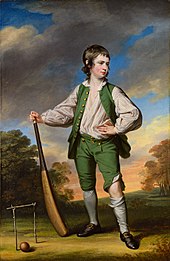
It is believed that cricket was originally a children's game but references in 1611[3] indicate that adults had started playing it and the earliest known organised inter-parish or village cricket match was played around that time.[8] In 1624, a player called Jasper Vinall died after he was struck on the head during a match between two parish teams in Sussex.[9] During the 17th century, numerous references indicate the growth of cricket in the south-east of England. By the end of the century, it had become an organised activity being played for high stakes and it is believed that the first professionals appeared in the years following the Restoration in 1660. A newspaper report survives of "a great cricket match" with eleven players a side that was played for high stakes in Sussex in 1697, and this is the earliest known reference to a cricket match of such importance.[10]
The game underwent major development in the 18th century. Betting played a key part in that development with rich patrons forming their own "select XIs".[11] Cricket was prominent in London as early as 1707 and, in the middle years of the century, large crowds flocked to matches on the Artillery Ground in Finsbury.[12] The single wicket form of the sport attracted huge crowds and wagers to match, its popularity peaking in the 1748 season.[13] Bowling underwent an evolution around 1760 when bowlers began to pitch the ball instead of rolling or skimming it towards the batsman. This caused a revolution in bat design because, to deal with the bouncing ball, it was necessary to introduce the modern straight bat in place of the old "hockey stick" shape.[14][15] The Hambledon Club was founded in the 1760s and, for the next twenty years until the formation of Marylebone Cricket Club (MCC) and the opening of Lord's Old Ground in 1787, Hambledon was both the game's greatest club and its focal point.[16] MCC quickly became the sport's premier club and the custodian of the Laws of Cricket. New Laws introduced in the latter part of the 18th century included the three stump wicket and leg before wicket (lbw).[17]
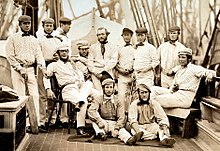
The 19th century saw underarm bowling superseded by first roundarm and then overarm bowling. Both developments were controversial.[18] Organisation of the game at county level led to the creation of the county clubs, starting with Sussex in 1839.[19] In December 1889, the eight leading county clubs formed the official County Championship, which began in 1890.[20] Meanwhile, the British Empire had been instrumental in spreading the game overseas and by the middle of the 19th century it had become well established in Australia, the Caribbean, India, New Zealand, North America and South Africa.[21] In 1844, the first-ever international match took place between the United States and Canada.[22] In 1859, a team of English players went to North America on the first overseas tour.[23]
The first Australian team to tour overseas was a team of Aboriginal stockmen who travelled to England in 1868 to play matches against county teams.[24] In 1862, an English team made the first tour of Australia.[25] The most famous player of the 19th century was W. G. Grace, who started his long and influential career in 1865.[26]
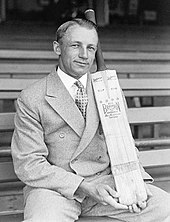
In 1876–77, an England team took part in what was retrospectively recognised as the first-ever Test match at the Melbourne Cricket Ground against Australia.[27] The rivalry between England and Australia gave birth to The Ashes in 1882 and this has remained Test cricket's most famous contest.[28] Test cricket began to expand in 1888–89 when South Africa played England.[29]
The last two decades before the First World War have been called the "Golden Age of cricket". It is a nostalgic name prompted by the collective sense of loss resulting from the war, but the period did produce some great players and memorable matches, especially as organised competition at county and Test level developed.[30]
The inter-war years were dominated by one player: Australia's Don Bradman, statistically the greatest Test batsman of all time.[31] Test cricket continued to expand during the 20th century with the addition of the West Indies (1928), New Zealand (1930) and India (1932) before the Second World War and then Pakistan (1952), Sri Lanka (1982), Zimbabwe (1992) and Bangladesh (2000) in the post-war period.[32][33][34][35] South Africa was banned from international cricket from 1970 to 1992 as part of the apartheid boycott.[36]
Cricket entered a new era in 1963 when English counties introduced the limited overs variant.[37] As it was sure to produce a result, limited overs cricket was lucrative and the number of matches increased.[38] The first Limited Overs International was played in 1971 and the governing International Cricket Council (ICC), seeing its potential, staged the first limited overs Cricket World Cup in 1975.[39] In the 21st century, a new limited overs form, Twenty20, made an immediate impact.[40][41] On 22 June 2017, Afghanistan and Ireland became the 11th and 12th ICC full members, enabling them to play Test cricket.[42][43]
Laws and gameplay
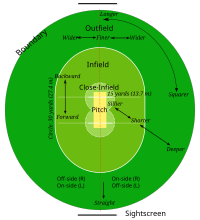
In cricket, the rules of the game are specified in a code called The Laws of Cricket (hereinafter called "the Laws") which has a global remit. There are 42 Laws (always written with a capital "L"). The earliest known version of the code was drafted in 1744 and, since 1788, it has been owned and maintained by its custodian, the Marylebone Cricket Club (MCC) in London.[44]
Playing area
Cricket is a bat-and-ball game played on a cricket field (see image, right) between two teams of eleven players each.[45] The field is usually circular or oval in shape and the edge of the playing area is marked by a boundary, which may be a fence, part of the stands, a rope, a painted line or a combination of these; the boundary must if possible be marked along its entire length.[46]
In the approximate centre of the field is a rectangular pitch (see image, below) on which a wooden target called a wicket is sited at each end; the wickets are placed 22 yards (20 m) apart.[47] The pitch is a flat surface 3 metres (9.8 ft) wide, with very short grass that tends to be worn away as the game progresses (cricket can also be played on artificial surfaces, notably matting). Each wicket is made of three wooden stumps topped by two bails.[48]

As illustrated above, the pitch is marked at each end with four white painted lines: a bowling crease, a popping crease and two return creases. The three stumps are aligned centrally on the bowling crease, which is eight feet eight inches long. The popping crease is drawn four feet in front of the bowling crease and parallel to it; although it is drawn as a twelve foot line (six feet either side of the wicket), it is in fact unlimited in length. The return creases are drawn at right angles to the popping crease so that they intersect the ends of the bowling crease; each return crease is drawn as an eight foot line, so that it extends four feet behind the bowling crease, but is also in fact unlimited in length.[49]
Match structure and closure
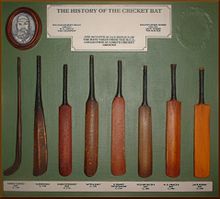

Before a match begins, the team captains (who are also players) toss a coin to decide which team will bat first and so take the first innings.[50] Innings is the term used for each phase of play in the match.[50] In each innings, one team bats, attempting to score runs, while the other team bowls and fields the ball, attempting to restrict the scoring and dismiss the batsmen.[51][52] When the first innings ends, the teams change roles; there can be two to four innings depending upon the type of match. A match with four scheduled innings is played over three to five days; a match with two scheduled innings is usually completed in a single day.[50] During an innings, all eleven members of the fielding team take the field, but only two members of the batting team are on the field at any given time.[50] The order of batsmen is usually announced just before the match, but it can be varied.[45]
The main objective of each team is to score more runs than their opponents but, in some forms of cricket, it is also necessary to dismiss all of the opposition batsmen in their final innings in order to win the match, which would otherwise be drawn.[53] If the team batting last is all out having scored fewer runs than their opponents, they are said to have "lost by n runs" (where n is the difference between the aggregate number of runs scored by the teams). If the team that bats last scores enough runs to win, it is said to have "won by n wickets", where n is the number of wickets left to fall. For example, a team that passes its opponents' total having lost six wickets (i.e., six of their batsmen have been dismissed) have won the match "by four wickets".[53]
In a two-innings-a-side match, one team's combined first and second innings total may be less than the other side's first innings total. The team with the greater score is then said to have "won by an innings and n runs", and does not need to bat again: n is the difference between the two teams' aggregate scores. If the team batting last is all out, and both sides have scored the same number of runs, then the match is a tie; this result is quite rare in matches of two innings a side with only 62 happening in first-class matches from the earliest known instance in 1741 until January 2017. In the traditional form of the game, if the time allotted for the match expires before either side can win, then the game is declared a draw.[53]
If the match has only a single innings per side, then a maximum number of overs applies to each innings. Such a match is called a "limited overs" or "one-day" match, and the side scoring more runs wins regardless of the number of wickets lost, so that a draw cannot occur. If this kind of match is temporarily interrupted by bad weather, then a complex mathematical formula, known as the Duckworth-Lewis method after its developers, is often used to recalculate a new target score. A one-day match can also be declared a "no-result" if fewer than a previously agreed number of overs have been bowled by either team, in circumstances that make normal resumption of play impossible; for example, wet weather.[53]
In all forms of cricket, the umpires can abandon the match if bad light or rain makes it impossible to continue.[54] There have been instances of entire matches, even Test matches scheduled to be played over five days, being lost to bad weather without a ball being bowled: for example, the third Test of the 1970/71 series in Australia.[55]
Bat and ball
i) A used white ball. White balls are mainly used in limited overs cricket, especially in matches played at night, under floodlights (left).
The essence of the sport is that a bowler delivers (i.e., bowls) the ball from his end of the pitch towards the batsman who, armed with a bat is "on strike" at the other end (see next sub-section: Basic gameplay).
The bat is made of wood, usually salix alba (white willow), and has the shape of a blade topped by a cylindrical handle. The blade must not be more than four and one quarter inches wide and the total length of the bat not more than 38 inches. There is no standard for the weight which is usually between 2 lb 7 oz to 3 lb.[56][57]
The ball is a hard leather-seamed spheroid, with a circumference of 22.9 centimetres (9.0 in). The ball has a "seam": six rows of stitches attaching the leather shell of the ball to the string and cork interior. The seam on a new ball is prominent, and helps the bowler propel it in a less predictable manner. During matches, the quality of the ball deteriorates to a point where it is no longer usable, and during the course of this deterioration its behaviour in flight will change and can influence the outcome of the match. Players will therefore attempt to modify the ball's behaviour by modifying its physical properties. Polishing the ball and wetting it with sweat or saliva is legal, even when the polishing is deliberately done on one side only to increase the ball's swing through the air, but the acts of rubbing other substances into the ball, scratching the surface or picking at the seam is illegal ball tampering.[58]
Basic gameplay: bowler to batsman
During normal play, thirteen players and two umpires are on the field. Two of the players are batsmen and the rest are all eleven members of the fielding team. The other nine players in the batting team are off the field in the pavilion. The image with overlay below shows what is happening when a ball is being bowled and which of the personnel are on or close to the pitch. The photo was taken during an international match between Australia and Sri Lanka; Muttiah Muralitharan of Sri Lanka is bowling to Australian batsman Adam Gilchrist.
| |||||||||||||||||||||||||||
In the photo, the two batsmen (3 & 8; wearing yellow) have taken position at each end of the pitch (6). Three members of the fielding team (4, 10 & 11; wearing dark blue) are in shot. One of the two umpires (1; wearing white hat) is stationed behind the wicket (2) at the bowler's (4) end of the pitch. The bowler (4) is bowling the ball (5) from his end of the pitch to the batsman (8) at the other end who is called the "striker". The other batsman (3) at the bowling end is called the "non-striker". The wicket-keeper (10), who is a specialist, is positioned behind the striker's wicket (9) and behind him stands one of the fielders in a position called "first slip" (11). While the bowler and the first slip are wearing conventional kit only, the two batsmen and the wicket-keeper are wearing protective gear including safety helmets, padded gloves and leg guards (pads).
While the umpire (1) in shot stands at the bowler's end of the pitch, his colleague stands in the outfield, usually in or near the fielding position called "square leg", so that he is in line with the popping crease (7) at the striker's end of the pitch. The bowling crease (not numbered) is the one on which the wicket is located between the return creases (12). The bowler (4) intends to hit the wicket (9) with the ball (5) or, at least, to prevent the striker (8) from scoring runs. The striker (8) intends, by using his bat, to defend his wicket and, if possible, to hit the ball away from the pitch in order to score runs.
Some players are skilled in both batting and bowling so are termed all-rounders. Adam Gilchrist, pictured above, was a wicket-keeper/batsman, another type of all-rounder. Bowlers are also classified according to their style, generally as fast bowlers, medium pace seam bowlers or, like Muttiah Muralitharan pictured above, spinners. Batsmen are classified according to whether they are right-handed or left-handed.
Fielding

Of the eleven fielders, three are in shot in the image above. The other eight are elsewhere on the field, their positions determined on a tactical basis by the captain and/or the bowler. Fielders often change position between deliveries, again as directed by the captain and/or bowler.[59]
If a fielder is injured or becomes ill during a match, a substitute is allowed to field instead of him, but the substitute cannot bowl, act as a captain or keep wicket. The substitute leaves the field when the injured player is fit to return.[60]
Specialist roles
The captain is often the most experienced player in the team, certainly the most tactically astute, and can possess any of the main skillsets as a batsman, a bowler or a wicket-keeper. Within the Laws, the captain has certain responsibilities in terms of nominating his players to the umpires before the match and ensuring that his players conduct themselves "within the spirit and traditions of the game as well as within the Laws".[45]
The wicket-keeper (sometimes called simply the "keeper") is a specialist fielder subject to various rules within the Laws about his equipment and demeanour. He is the only member of the fielding side who can effect a stumping and is the only one permitted to wear gloves and external leg guards.[61] Depending on their primary skills, the other ten players in the team tend to be classified as specialist batsmen or specialist bowlers. Generally, a team will include five or six specialist batsmen and four or five specialist bowlers, plus the wicket-keeper.[62][63]
Clothing and equipment

The wicket-keeper and the batsmen wear protective gear because of the hardness of the ball, which can be delivered at speeds of more than 145 kilometres per hour (90 mph) and presents a major health and safety concern. Protective clothing includes pads (designed to protect the knees and shins), batting gloves or wicket-keeper's gloves for the hands, a safety helmet for the head and a box inside the trousers (to protect the crotch area).[64] Some batsmen wear additional padding inside their shirts and trousers such as thigh pads, arm pads, rib protectors and shoulder pads. The only fielders allowed to wear protective gear are those in positions very close to the batsman (i.e., if they are alongside or in front of him), but they cannot wear gloves or external leg guards.[59]
Subject to certain variations, on-field clothing generally includes a collared shirt with short or long sleeves; long trousers; woollen pullover (if needed); cricket cap (for fielding) or a safety helmet; and spiked shoes or boots to increase traction. The kit is traditionally all white and this remains the case in Test and first-class cricket but, in limited overs cricket, team colours are worn instead.[65]
Innings
The innings (ending with 's' in both singular and plural form) is the term used for each phase of play during a match. Depending on the type of match being played, each team has either one or two innings. Sometimes all eleven members of the batting side take a turn to bat but, for various reasons, an innings can end before they have all done so. The innings terminates if the batting team is "all out", a term defined by the Laws: "at the fall of a wicket or the retirement of a batsman, further balls remain to be bowled but no further batsman is available to come in".[50] In this situation, one of the batsman has not been dismissed and is termed not out; this is because he has no partners left and there must always be two active batsmen while the innings is in progress.
An innings may end early, while there are still two not out batsmen, for a number of reasons. First, a set number of overs has been played (e.g., in a limited overs match. Second, the batting team's captain declares the innings closed even though some of his players have not had a turn to bat: this a tactical decisons by the captain, usually because he believes his team have scored sufficient runs and he needs time to dismiss the opposition in their innings. Third, the match has ended prematurely due to bad weather or running out of time. Fourth, in the final innings of the match, the batting side has reached its target and won the game.[50]
Overs
The Laws state that, throughout an innings, "the ball shall be bowled from each end alternately in overs of 6 balls".[66] The name "over" came about because the umpire calls "Over!" when six balls have been bowled. At this point, another bowler is deployed at the other end, and the fielding side changes ends while the batsmen do not. A bowler cannot bowl two successive overs, although a bowler can (and usually does) bowl alternate overs, from the same end, for several overs which are termed a "spell". The batsmen do not change ends at the end of the over, and so the one who was non-striker is now the striker and vice-versa. The umpires also change positions so that the one who was at "square leg" now stands behind the wicket at the non-striker's end and vice-versa.[66]
Umpires and scorers
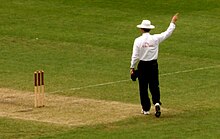
The game on the field is regulated by the two umpires, one of whom stands behind the wicket at the bowler's end, the other in a position called "square leg" which is about 15–20 metres away from the batsman on strike and in line with the popping crease on which he is taking guard. The umpires have several responsibilities including: adjudication on whether a ball has been correctly bowled (i.e., not a no ball or a wide); when a run is scored; whether a batsman is out (the fielding side must first appeal to the umpire, usually with the phrase "How's that?" or "Owzat?"); when intervals start and end; and the suitability of the pitch, field and/or weather for playing the game. The umpires are authorised to interrupt or even abandon a match due to circumstances likely to endanger the players, such as a damp pitch or deterioration of the light.[54]
Off the field in televised matches, there is usually a third umpire who can make decisions on certain incidents with the aid of video evidence. The third umpire is mandatory under the playing conditions for Test and Limited Overs International matches played between two ICC full member countries. These matches also have a match referee whose job is to ensure that play is within the Laws and the spirit of the game.[54]
The match details, including runs and dismissals, are recorded by two official scorers, one representing each team. The scorers are directed by the hand signals of an umpire (see image, right). For example, the umpire raises a forefinger to signal that the batsman is out (has been dismissed); he raises both arms above his head if the batsman has hit the ball for six runs. The scorers are required by the Laws to record all runs scored, wickets taken and overs bowled; in practice, they also note significant amounts of additional data relating to the game.[67]
A match's statistics are summarised on a scorecard. Prior to the popularisation of scorecards, most scoring was done by men sitting on vantage points cuttings notches on tally sticks and runs were originally called notches.[68] According to Rowland Bowen, the earliest known scorecard templates were introduced in 1776 by T. Pratt of Sevenoaks and soon came into general use.[69] It is believed that scorecards were printed and sold at Lord's for the first time in 1846.[70]
Spirit of the Game
Besides observing the Laws, cricketers must respect the "Spirit of the Game" and the Preamble to the Laws, first published in the 2000 code, opens with this statement:[71]
"Cricket is a game that owes much of its unique appeal to the fact that it should be played not only within its Laws but also within the Spirit of the Game".
The onus for ensuring that a team complies is placed firmly on the captain who may be required by the umpires to "take action" against any player on his team whose behaviour is unacceptable and may bring the sport into disrepute.[71] The umpires are the sole judges of fair and unfair play. They are required to intervene if players are inter alia wasting time, damaging the pitch, tampering with the ball or showing disrespect to other players or to the umpires themselves.[71]
Bowling and dismissal

Most bowlers are considered specialists in that they are selected for the team because of their skill as a bowler, although some are all-rounders and even specialist batsmen bowl occasionally. The specialist bowlers are active multiple times during an innings, but may not bowl two overs consecutively. If the captain wants a bowler to "change ends", another bowler must temporarily fill in so that the change is not immediate.[66]
A bowler reaches his delivery stride by means of a "run-up" and an over is deemed to have begun when the bowler starts his run up for the first delivery of that over, the ball then being "in play".[66] Fast bowlers, needing momentum, take a lengthy run up while bowlers with a slow delivery take no more than a couple of steps before bowling. The fastest bowlers can deliver the ball at a speed of over 145 kilometres per hour (90 mph) and they sometimes rely on sheer speed to try and defeat the batsman, who is forced to react very quickly.[73] Other fast bowlers rely on a mixture of speed and guile by making use of the seam of the ball so that it "swings" (or "curves") in flight. This type of delivery can deceive a batsman into mistiming his shot so that the ball just touches the edge of the bat and can then be "caught behind" by the wicket-keeper or a slip fielder.[73] At the other end of the bowling scale is the spin bowler who bowls at a relatively slow pace and relies entirely on guile to deceive the batsman. A spinner will often "buy his wicket" by "tossing one up" (in a slower, steeper parabolic path) to lure the batsman into making a poor shot. The batsman has to be very wary of such deliveries as they are often "flighted" or spun so that the ball will not behave quite as he expects and he could be "trapped" into getting himself out.[74] In between the pacemen and the spinners are the medium paced seamers who rely on persistent accuracy to try and contain the rate of scoring and wear down the batsman's concentration.[73]
There are ten ways in which a batsman can be dismissed: five relatively common and six extremely rare. The common forms of dismissal are bowled,[75] caught,[76] leg before wicket (lbw),[77] run out[78] and stumped.[79] Rare methods are hit wicket,[80] hit the ball twice,[81] obstructing the field,[82] handled the ball[83] and timed out.[84] An effectively eleventh method, retired out, is not an on-field dismissal as such but rather a retrospective one for which no fielder is credited. The Laws state that the fielding team, usually the bowler in practice, must appeal for a dismissal before the umpire can give his decision. If the batsman is out, the umpire raises a forefinger and says "Out!"; otherwise, he will shake his head and say "Not out".[85]
Batting, runs and extras
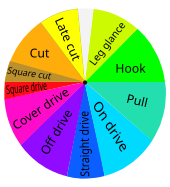
Batsmen take turns to bat via a batting order which is decided beforehand by the team captain and presented to the umpires, though the order remains flexible, when the captain officially nominates the team.[45] Substitute batsmen are not allowed.[60]
A skilled batsman can use a wide array of "shots" or "strokes" in both defensive and attacking mode. The idea is to hit the ball to best effect with the flat surface of the bat's blade. If the ball touches the side of the bat it is called an "edge". The batsman does not have to play a shot and can allow the ball to go through to the wicketkeeper. Equally, he does not have to attempt a run when he hits the ball with his bat. Batsmen do not always seek to hit the ball as hard as possible, and a good player can score runs just by making a deft stroke with a turn of the wrists or by simply "blocking" the ball but directing it away from fielders so that he has time to take a run. A wide variety of shots are played, the batsman's repertoire including strokes named according to the style of swing and the direction aimed: e.g., "cut", "drive", "hook", "pull".[86]
The batsman on strike (i.e. the "striker") must prevent the ball hitting the wicket, and try to score runs by hitting the ball with his bat so that he and his partner have time to run from one end of the pitch to the other before the fielding side can return the ball. To register a run, both runners must touch the ground behind the crease with either their bats or their bodies (the batsmen carry their bats as they run). Each completed run increments the score of both the team and the striker.[87]

The decision to attempt a run is ideally made by the batsman who has the better view of the ball's progress, and this is communicated by calling: usually "yes", "no" or "wait". More than one run can be scored from a single hit: hits worth one to three runs are common, but the size of the field is such that it is usually difficult to run four or more.[87] To compensate for this, hits that reach the boundary of the field are automatically awarded four runs if the ball touches the ground en route to the boundary or six runs if the ball clears the boundary without touching the ground within the boundary. In these cases the batsmen do not need to run.[88] Hits for five are unusual and generally rely on the help of "overthrows" by a fielder returning the ball. If an odd number of runs is scored by the striker, the two batsmen have changed ends, and the one who was non-striker is now the striker. Only the striker can score individual runs, but all runs are added to the team's total.[87]
Additional runs can be gained by the batting team as extras (called "sundries" in Australia) due to errors made by the fielding side. This is achieved in four ways: no ball, a penalty of one extra conceded by the bowler if he breaks the rules;[89] wide, a penalty of one extra conceded by the bowler if he bowls so that the ball is out of the batsman's reach;[90] bye, an extra awarded if the batsman misses the ball and it goes past the wicket-keeper and gives the batsmen time to run in the conventional way;[91] leg bye, as for a bye except that the ball has hit the batsman's body, though not his bat.[91] If the bowler has conceded a no ball or a wide, his team incurs an additional penalty because that ball (i.e., delivery) has to be bowled again and hence the batting side has the opportunity to score more runs from this extra ball.[89][90]
Women's cricket
Women's cricket was first recorded in Surrey in 1745.[92] International development began at the start of the 20th century and the first Test Match was played between Australia and England in December 1934.[93] In 1958, the International Women's Cricket Council was founded (it merged with the ICC in 2005).[93] In 1973, the first Cricket World Cup of any kind took place when a Women's World Cup was held in England.[93]
International structure
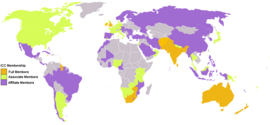
The International Cricket Council (ICC), which has its headquarters in Dubai, is the global governing body of cricket. It was founded as the Imperial Cricket Conference in 1909 by representatives from England, Australia and South Africa, renamed the International Cricket Conference in 1965, and took up its current name in 1989.[93] The ICC in 2017 has 105 member nations, twelve of which hold full membership and can play Test cricket.[94] The ICC is responsible for the organisation and governance of cricket's major international tournaments, notably the men's and women's versions of the Cricket World Cup. It also appoints the umpires and referees that officiate at all sanctioned Test matches, Limited Overs Internationals and Twenty20 Internationals. Each member nation has a national cricket board which regulates cricket matches played in its country (e.g., England and Wales Cricket Board, Cricket Australia). The cricket board selects the national squad and organises home and away tours for the national team.[95] In the West Indies, which for cricket purposes is a federation of nations, these matters are addressed by Cricket West Indies.[96]
The table below summarises the full members:[97]
| Nation | Governing body | Member since[98] | Current Test rankings |
Current ODI rankings |
Current T20 rankings |
|---|---|---|---|---|---|
| Afghanistan Cricket Board | 22 June 2017 | 10 | 9 | ||
| Cricket Australia | 15 July 1909 | 2 | 2 | 7 | |
| Bangladesh Cricket Board | 26 June 2000 | 9 | 7 | 10 | |
| England and Wales Cricket Board | 15 July 1909 | 4 | 5 | 5 | |
| Board of Control for Cricket in India | 31 May 1926 | 1 | 4 | 2 | |
| Cricket Ireland | 22 June 2017 | 12 | 18 | ||
| New Zealand Cricket | 31 May 1926 | 5 | 3 | 1 | |
| Pakistan Cricket Board | 28 July 1953 | 6 | 6 | 6 | |
| Cricket South Africa | 15 July 1909 | 3 | 1 | 3 | |
| Sri Lanka Cricket | 21 July 1981 | 7 | 8 | 8 | |
| Cricket West Indies | 31 May 1926 | 8 | 9 | 4 | |
| Zimbabwe Cricket | 6 July 1992 | 10 | 11 | 12 |
Types of match
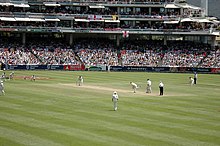
Cricket is a multi-faceted sport with multiple formats that can effectively be divided into first-class cricket, limited overs cricket and, historically, single wicket cricket. The highest standard is Test cricket (always written with a capital "T") which is in effect the international version of first-class cricket and is restricted to teams representing the twelve countries that are full members of the ICC (see above). Although the term "Test match" was not coined until much later, Test cricket is deemed to have begun with two matches between Australia and England in the 1876–77 Australian season; since 1882, most Test series between England and Australia have been played for a trophy known as The Ashes. The term "first-class", in general usage, is applied to top-level domestic cricket. Test matches are played over five days and first-class over three to four days; in all of these matches, the teams are allotted two innings each and the draw is a valid result.[99]
Limited overs cricket is always scheduled for completion in a single day. There are two types: List A which normally allows fifty overs per team; and Twenty20 in which the teams have twenty overs each. Both of the limited overs forms are played internationally as Limited Overs Internationals (LOI) and Twenty20 Internationals (T20I). List A was introduced in England in the 1963 season as a knockout cup contested by the first-class county clubs. In 1969, a national league competition was established. The concept was gradually introduced to the other leading cricket countries and the first limited overs international was played in 1971. In 1975, the first Cricket World Cup took place in England. Twenty20 is a new variant of limited overs itself with the purpose being to complete the match within about three hours, usually in an evening session. The first Twenty20 World Championship was held in 2007. Limited overs matches cannot be drawn, although a tie is possible and an unfinished match is a "no result".[100][101]
Single wicket was popular in the 18th and 19th centuries and its matches generally qualify as important. In this form, although each team may have from one to six players, there is only one batsman in at a time and he must face every delivery bowled while his innings lasts. Single wicket has rarely been played since limited overs cricket began. Matches tended to have two innings per team like a full first-class one and they could end in a draw.[102]
National championships

First-class cricket in England is played for the most part by the 18 county clubs which contest the County Championship. The concept of a champion county has existed since the 18th century but the official competition was not established until 1890.[103] The most successful club has been Yorkshire, who had won 32 official titles (plus one shared) to 2015.[104]
Australia established its national first-class championship in 1892–93 when the Sheffield Shield was introduced. In Australia, the first-class teams represent the various states.[105] New South Wales has the highest number of titles. The other ICC full members have national championship trophies called the National Cricket League (Bangladesh), Ranji Trophy (India), Plunket Shield (New Zealand), Quaid-e-Azam Trophy (Pakistan), Currie Cup (South Africa), Premier Trophy (Sri Lanka), Shell Shield (West Indies) and Logan Cup (Zimbabwe).
Club and school cricket
The world's earliest known cricket match was a village cricket meeting in Kent which has been deduced from a 1640 court case recording a "cricketing" of "the Weald and the Upland" versus "the Chalk Hill" at Chevening "about thirty years since" (i.e., c.1611). Inter-parish contests became popular in the first half of the 17th century and continued to develop through the 18th with the first local leagues being founded in the second half of the 19th.[106]
At the grassroots level, local club cricket is essentially an amateur pastime for those involved but still usually involves teams playing in competitions at weekends or in the evening. Schools cricket, first known in southern England in the 17th century, has a similar scenario and both are widely played in the countries where cricket is popular.[107] Although there can be variations in game format, compared with professional cricket, the Laws are always observed and club/school matches are therefore formal and competitive events.[108] The sport has numerous informal variants such as French cricket.[109]
Culture
Influence on everyday life
Cricket has had a broad impact on popular culture, both in the Commonwealth of Nations and elsewhere. It has, for example, influenced the lexicon of these nations, especially the English language, with various phrases such as "that's not cricket" (that's unfair), "had a good innings" (lived a long life) and "sticky wicket". "On a sticky wicket" (aka "sticky dog" or "glue pot")[110] is a metaphor[111] used to describe a difficult circumstance. It originated as a term for difficult batting conditions in cricket, caused by a damp and soft pitch.[112]
In the arts and popular culture
Cricket is the subject of works by noted English poets, including William Blake and Lord Byron.[113] Beyond a Boundary (1963), written by Trinidadian C. L. R. James, is often named the best book on any sport, ever written.[114]

In the visual arts, notable cricket paintings include Albert Chevallier Tayler's Kent vs Lancashire at Canterbury (1907) and Russell Drysdale's The Cricketers (1948), which has been called "possibly the most famous Australian painting of the 20th century."[115] French impressionist Camille Pissarro painted cricket on a visit to England in the 1890s.[113] Francis Bacon, an avid cricket fan, captured a batsman in motion.[113] Caribbean artist Wendy Nanan's cricket images[116] are featured in a limited edition first day cover for Royal Mail's "World of Invention" stamp issue, which celebrated the London Cricket Conference 1–3 March 2007, first international workshop of its kind and part of the celebrations leading up to the 2007 Cricket World Cup.[117]
Influence on other sports
In England, a number of association football clubs owe their origins to cricketers who sought to play football as a means of keeping fit during the winter months. Derby County was founded as a branch of the Derbyshire County Cricket Club in 1884;[118] Aston Villa (1874) and Everton (1876) were both founded by members of church cricket teams.[119] Sheffield United's Bramall Lane ground was, from 1854, the home of the Sheffield Cricket Club, and then of Yorkshire; it was not used for football until 1862 and was shared by Yorkshire and Sheffield United from 1889 to 1973.[120]
Cricket has close historical ties with Australian rules football and many players have competed at top levels in both sports.[121] In 1858, prominent Australian cricketer Tom Wills called for the formation of a "foot-ball club" with "a code of laws" to keep cricketers fit during the off-season. The Melbourne Football Club was founded the following year, and Wills and three other members codified the first laws of the game.[122] It is typically played on modified cricket fields.[123]
In the late 19th century, a former cricketer, English-born Henry Chadwick of Brooklyn, New York, was credited with devising the baseball box score[124] (which he adapted from the cricket scorecard) for reporting game events. The first box score appeared in an 1859 issue of the Clipper.[125] The statistical record is so central to the game's "historical essence" that Chadwick is sometimes referred to as "the Father of Baseball" because he facilitated the popularity of the sport in its early days.[126]
See also
References
- ^ Leach, John (2007). "From Lads to Lord's – 1597". Stumpsite. Archived from the original on 29 June 2011. Retrieved 31 January 2009.
{{cite web}}: Unknown parameter|deadurl=ignored (|url-status=suggested) (help) This quotes the precise date of the court case in Guildford as Monday, 17 January 1597 (Julian date), which is in the Gregorian year of 1598. Retrieved 31 January 2009. - ^ a b c Birley, p. 3.
- ^ a b c Altham, p. 21.
- ^ Bowen, p. 33.
- ^ Terry, David (2008). "The Seventeenth Century Game of Cricket: A Reconstruction of the Game" (PDF). SportsLibrary. Archived from the original (PDF) on 27 November 2009. Retrieved 2 May 2016.
{{cite web}}: Unknown parameter|deadurl=ignored (|url-status=suggested) (help) - ^ Gillmeister's theory is summarised in the introduction to the book The Language of Cricket by John Eddowes, ISBN 1-85754-270-3.
- ^ Underdown, p. 3.
- ^ Underdown, p. 4.
- ^ McCann, pp. xxxiii–xxxiv.
- ^ McCann, p. xli.
- ^ Birley, pp. 14–16.
- ^ Leach, John (2007). "From Lads to Lord's – Artillery Ground". Stumpsite. Archived from the original on 29 June 2011. Retrieved 1 July 2017.
{{cite web}}: Unknown parameter|deadurl=ignored (|url-status=suggested) (help) - ^ Ashley-Cooper, At the Sign of the Wicket, 12 April 1900, p. 52.
- ^ Nyren, pp. 153–154.
- ^ Leach, John (2007). "From Lads to Lord's – The first bowling revolution". Stumpsite. Archived from the original on 29 June 2011. Retrieved 1 July 2017.
{{cite web}}: Unknown parameter|deadurl=ignored (|url-status=suggested) (help) - ^ Leach, John (2007). "From Lads to Lord's – Hambledon". Stumpsite. Archived from the original on 29 June 2011. Retrieved 1 July 2017.
{{cite web}}: Unknown parameter|deadurl=ignored (|url-status=suggested) (help) - ^ Wisden. "Evolution of the Laws of Cricket". Wisden Cricketers' Almanack, 100th edition (1963 ed.). London: Sporting Handbooks Ltd. pp. 184–187.
- ^ Birley, pp. 64–67 and 97–101.
- ^ Barclays, p.456.
- ^ "Annual Meeting of County Secretaries – the programme for 1890". Cricket: A Weekly Record of the Game. ACS. 1889. pp. 478–479. Retrieved 3 July 2017.
- ^ Barclays, pp. 62, 78, 87, 99, 113, 127 & 131.
- ^ Das, Deb (n.d.). "Cricinfo – Cricket in the USA". ESPNcricinfo. Retrieved 9 March 2007.
- ^ Birley, pp. 96–97.
- ^ "The Australian Eleven: The first Australian team". National Museum of Australia. Retrieved 30 December 2014.
- ^ Birley, p. 97.
- ^ "Teams that W. G. Grace played for". CricketArchive. Retrieved 2 July 2017.
{{cite web}}: Italic or bold markup not allowed in:|publisher=(help) - ^ "Australia v England in 1876/77 (1st Test)". CricketArchive. Retrieved 2 July 2017.
- ^ Lewis, Wendy; Simon Balderstone; John Bowan (2006). Events That Shaped Australia. New Holland. p. 75. ISBN 978-1-74110-492-9.
{{cite book}}: Unknown parameter|last-author-amp=ignored (|name-list-style=suggested) (help) - ^ "South Africa v England in 1888/89 (1st Test)". CricketArchive. Retrieved 2 July 2017.
- ^ Frith, David (1978). The Golden Age of Cricket: 1890–1914. Lutterworth Press.
- ^ "Test matches: Highest career batting average". ESPNcricinfo. Retrieved 2 July 2017.
- ^ Wisden. "Dates in Cricket History". Wisden Cricketers' Almanack, 100th edition (1963 ed.). London: Sporting Handbooks Ltd. p. 183.
- ^ "Notes by the Editor". Wisden Cricketers' Almanack online. ESPNcricinfo. 1982. Retrieved 2 July 2017.
- ^ "Zimbabwe v India in 1992/93 (Only Test)". CricketArchive. Retrieved 2 July 2017.
- ^ "Bangladesh v India in 2000/01 (Only Test)". CricketArchive. Retrieved 2 July 2017.
- ^ Booth, Douglas (1998). The Race Game: Sport and Politics in South Africa. Routledge. p. 88. ISBN 0-7146-4799-3.
- ^ Wisden. "One-Day Knockout Competition, 1963". Wisden Cricketers' Almanack, 100th edition (1963 ed.). London: Sporting Handbooks Ltd. pp. 1074–1076.
- ^ Barclays, pp. 495–496.
- ^ Barclays, pp. 496–497.
- ^ "The first official T20 in 2003". ESPNcricinfo. 12 March 2016. Retrieved 2 July 2017.
- ^ "India hold their nerve to win thriller". ESPNcricinfo. 24 September 2007. Retrieved 2 July 2017.
- ^ "Afghanistan, Ireland get Test status". ESPNcricinfo. Retrieved 2 July 2017.
- ^ "Ireland & Afghanistan awarded Test status by International Cricket Council". BBC Sport. 2017. Retrieved 2 July 2017.
- ^ "Laws". Laws of Cricket. MCC. Retrieved 4 July 2017.
- ^ a b c d "Law 1 – Players". Laws of Cricket. MCC. Retrieved 1 July 2017.
- ^ "Law 19 – Boundaries". Laws of Cricket. MCC. Retrieved 3 July 2017.
- ^ "Law 7 – The pitch". Laws of Cricket. MCC. Retrieved 3 July 2017.
- ^ "Law 8 – The wickets". Laws of Cricket. MCC. Retrieved 3 July 2017.
- ^ "Law 9 – The bowling, popping and return creases". Laws of Cricket. MCC. Retrieved 3 July 2017.
- ^ a b c d e f "Law 12 – Innings". Laws of Cricket. MCC. Retrieved 2 July 2017.
- ^ "Law 18 – Scoring runs". Laws of Cricket. MCC. Retrieved 2 July 2017.
- ^ "Law 27 – Appeals". Laws of Cricket. MCC. Retrieved 2 July 2017.
- ^ a b c d "Law 21 – The result". Laws of Cricket. MCC. Retrieved 2 July 2017.
- ^ a b c "Law 3 – The umpires". Laws of Cricket. MCC. Retrieved 4 July 2017.
- ^ "Australia v England, 3rd Test, 1970/71". CricketArchive. Retrieved 4 July 2017.
- ^ "Law 6 – The bat". Laws of Cricket. MCC. Retrieved 4 July 2017.
- ^ "Appendix E – The bat". Laws of Cricket. MCC. Retrieved 4 July 2017.
- ^ "Law 5 – The ball". Laws of Cricket. MCC. Retrieved 4 July 2017.
- ^ a b "Law 41 – The fielder". Laws of Cricket. MCC. Retrieved 7 July 2017.
- ^ a b "Law 2 – Substitutes, etc". Laws of Cricket. MCC. Retrieved 7 July 2017.
- ^ "Law 40 – The wicket-keeper". Laws of Cricket. MCC. Retrieved 4 July 2017.
- ^ "Bowling Strategy". TalkCricket. talkCricket. Retrieved 7 July 2017.
- ^ "Batting Strategy". TalkCricket. talkCricket. Retrieved 7 July 2017.
- ^ "Appendix D". Laws of Cricket. MCC. Retrieved 7 July 2017.
- ^ Birley, p. 343.
- ^ a b c d "Law 22 – The over". Laws of Cricket. MCC. Retrieved 4 July 2017.
- ^ "Law 4 – The scorers". Laws of Cricket. MCC. Retrieved 4 July 2017.
- ^ Bowen, p. 57.
- ^ Bowen, p. 266.
- ^ Bowen, p. 274.
- ^ a b c "Preamble to the Laws". Laws of Cricket. MCC. Retrieved 5 July 2017.
- ^ "Fastest delivery of a cricket ball (male)". Guinness World Records. Retrieved 23 June 2015.
- ^ a b c "Types of fast bowling". TalkCricket. talkCricket. Retrieved 6 July 2017.
- ^ "Spin bowling". TalkCricket. talkCricket. Retrieved 6 July 2017.
- ^ "Law 30 – Bowled". Laws of Cricket. MCC. Retrieved 6 July 2017.
- ^ "Law 32 – Caught". Laws of Cricket. MCC. Retrieved 6 July 2017.
- ^ "Law 36 – Leg before wicket". Laws of Cricket. MCC. Retrieved 6 July 2017.
- ^ "Law 38 – Run out". Laws of Cricket. MCC. Retrieved 6 July 2017.
- ^ "Law 39 – Stumped". Laws of Cricket. MCC. Retrieved 6 July 2017.
- ^ "Law 35 – Hit wicket". Laws of Cricket. MCC. Retrieved 6 July 2017.
- ^ "Law 34 – Hit the ball twice". Laws of Cricket. MCC. Retrieved 6 July 2017.
- ^ "Law 37 – Obstructing the field". Laws of Cricket. MCC. Retrieved 6 July 2017.
- ^ "Law 33 – Handled the ball". Laws of Cricket. MCC. Retrieved 6 July 2017.
- ^ "Law 31 – Timed out". Laws of Cricket. MCC. Retrieved 6 July 2017.
- ^ "Law 27 – Appeals". Laws of Cricket. MCC. Retrieved 6 July 2017.
- ^ "Batting". TalkCricket. talkCricket. Retrieved 7 July 2017.
- ^ a b c "Law 18 – Scoring runs". Laws of Cricket. MCC. Retrieved 7 July 2017.
- ^ "Law 19 – Boundaries". Laws of Cricket. MCC. Retrieved 7 July 2017.
- ^ a b "Law 24 – No ball". Laws of Cricket. MCC. Retrieved 7 July 2017.
- ^ a b "Law 25 – Wide ball". Laws of Cricket. MCC. Retrieved 7 July 2017.
- ^ a b "Law 26 – Bye and Leg bye". Laws of Cricket. MCC. Retrieved 7 July 2017.
- ^ "ICC History of Cricket (pre-1799)". ICC. Retrieved 7 July 2017.
- ^ a b c d "ICC History of Cricket (20th century)". ICC. Retrieved 7 July 2017.
- ^ "About the ICC". ICC. Retrieved 7 July 2017.
- ^ "About the England and Wales Cricket Board". ECB. Retrieved 7 July 2017.
- ^ "Cricket West Indies". Cricket West Indies. Retrieved 7 July 2017.
- ^ "ICC Rankings". International Cricket Council. ICC Development (International) Limited. Retrieved 9 February 2016.
- ^ "A brief history ..." Cricinfo. Retrieved 2 May 2008.
- ^ Rundell, Michael (2006). Dictionary of Cricket. London: A&C Black Publishers Ltd. p. 336. ISBN 978-0-7136-7915-1. Retrieved 17 October 2011.
- ^ "ICC clarification of limited overs". ESPNcricinfo. Retrieved 8 July 2017.
- ^ "The first official T20". ESPNcricinfo. Retrieved 8 July 2017.
- ^ Major, pp. 155–167 & 404–410.
- ^ "Annual Meeting of County Secretaries – the programme for 1890". Cricket: A Weekly Record of the Game. ACS. 1889. pp. 478–479. Retrieved 3 July 2017.
- ^ Playfair. Marshall, Ian (ed.). Playfair Cricket Annual (70th edition) (2017 ed.). London: Headline. p. 216.
- ^ Harte, Chris (1993). A History of Australian Cricket. Andre Deutsch. p. 175. ISBN 0 233 98825 4.
- ^ Underdown, p. 4.
- ^ Birley, pp. 9–10.
- ^ Birley, pp. 151–152.
- ^ "Rules of French Cricket". topend sports. Retrieved 8 July 2017.
- ^ Green, Jonathon (1987). Dictionary of Jargon. Routledge. p. 528. ISBN 9780710099198.
- ^ Marcus Callies; Wolfram R. Keller; Astrid Lohöfer (2011). Bi-directionality in the Cognitive Sciences: Avenues, Challenges, and Limitations. John Benjamins Publishing. pp. 73–. ISBN 90-272-2384-X.
- ^ Robert Hendrickson (26 April 2001). World English: From Aloha to Zed. Wiley. ISBN 978-0-471-34518-3.
- ^ a b c Smart, Alastair (20 July 2013). "The art of cricket: Enough to leave you stumped", The Telegraph. Retrieved 12 March 2016.
- ^ Rosengarten, Frank. Urbane Revolutionary: C. L. R. James and the Struggle for a New Society. University Press of Mississippi, 2007. ISBN 87-7289-096-7, p. 134
- ^ Meacham, Steve (6 June 2009). "Montmartre, with eucalypts". Sydney Morning Herald. Fairfax. Retrieved 31 August 2009.
- ^ "Caribbean cricket art, in the middle". BBC News. Retrieved 11 June 2016.
- ^ "Cricket: Dawn of a New World". Bletchley Park Post Office. March 2007. Retrieved 11 June 2016.
- ^ Goldstein, p. 184.
- ^ Goldstein, pp. 15 & 184.
- ^ Goldstein, p. 458.
- ^ Blainey, Geoffrey (2010). A Game of Our Own: The Origins of Australian Football. Black Inc. p. 186. ISBN 1-86395-347-7.
- ^ de Moore, Greg (2008). Tom Wills: His Spectacular Rise and Tragic Fall. Allen & Unwin. pp. 77, 93–94. ISBN 978-1-74175-499-5.
- ^ Hess, Rob (2008). A National Game: The History of Australian Rules Football. Viking. p. 44. ISBN 978-0-670-07089-3.
- ^ His Hall of Fame plaque states, in part: "Inventor of the box score. Author of the first rule-book ... Chairman of rules committee in first nationwide baseball organization." Lederer, Rich. By the Numbers: Computer technology has deepened fans' passion with the game's statistics. Memories and Dreams (Vol. 33, No. 6; Winter 2011[–2012], pp. 32–34). National Baseball Hall of Fame official magazine.
- ^ Pesca, Mike (30 July 2009). "The Man Who Made Baseball's Box Score A Hit". National Public Radio. Retrieved 8 March 2014.
- ^ Arango, Tim (12 November 2010). "Myth of baseball's creation endures, with a prominent fan". The New York Times. Retrieved 8 November 2014.
Bibliography
- Altham, H. S. (1962). A History of Cricket, Volume 1 (to 1914). George Allen & Unwin.
- Ashley-Cooper, F. S. (1900). At the Sign of the Wicket: Cricket 1742–1751. Cricket magazine.
{{cite book}}: Italic or bold markup not allowed in:|publisher=(help) - Barclays (1986). Swanton, E. W. (ed.). Barclays World of Cricket. Willow Books. ISBN 0-00-218193-2.
- Birley, Derek (1999). A Social History of English Cricket. Aurum. ISBN 1-85410-710-0.
- Bowen, Rowland (1970). Cricket: A History of its Growth and Development. Eyre & Spottiswoode.
- Goldstein, Dan (2000). The Rough Guide to English Football (2000–2001). Rough Guides.
- Major, John (2007). More Than A Game. HarperCollins.
- McCann, Tim (2004). Sussex Cricket in the Eighteenth Century. Sussex Record Society.
- Underdown, David (2000). Start of Play. Allen Lane.

